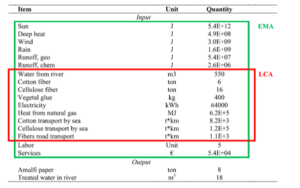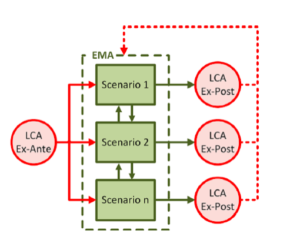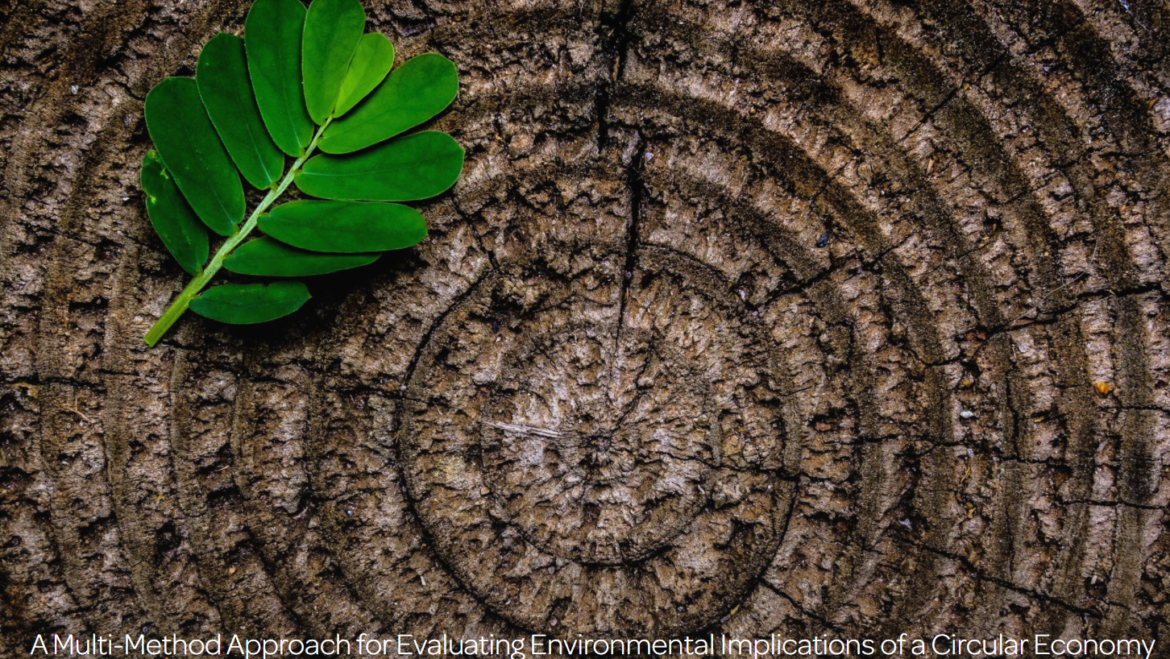by Amos Ncube
Despite a growing momentum to transition to a circular economy, there is currently no consensus on how organisations can measure their effectiveness in moving towards circularity. This makes CE assessments difficult to plan, manage and monitor from an environmental point of view. in this article, I promote a multi-method approach that integrates Life Cycle Assessment and Emergy Accounting to carry out environmental evaluations.
A circular economy (CE) can be defined as an economic model aimed at the efficient use of resources through waste minimisation, long-term value retention, reduction of primary resources, and closed loops of products, product parts, and materials within the boundaries of environmental protection and socioeconomic benefits. The CE paradigm is expected to play a pivotal role to achieve the 17 Sustainable Development Goals (SDGs) of the United Nations 2030 Agenda. Consequently, there appears to be a strong impetus across the board to adopt circularity targets. According to the World Economic Forum (WEF), the momentum to step away from a take-make-waste economic model is growing and both the private and public sectors are beginning to set up their own ambitious circular targets.
However, the measurement of the degree of implementation of CE is still a challenging task, owing to an absence of sound measures and methodologies. In order for institutions and organizations to be able to assess their circular performance, they need consistent measurement processes and multiple metrics. Presently, there is no consensus approach on how organizations can measure their effectiveness in moving towards circularity. This makes CE assessments difficult to plan, manage and monitor from an environmental point of view especially in situations where increased circularity could lead to a worse performance in terms of environmental sustainability.
“Presently, there is no consensus approach on how organisations can measure their effectiveness in moving towards circularity”
You cannot manage what you have not measured’ – the urgent need to measure CE
There is an emerging consensus that a transition towards CE is critical to achieving economic growth and environmental protection. But for this to successfully happen, the need to properly evaluate the environmental implications of this transition is urgently needed to provide information that can assist in decision making. An understanding of the environmental implications of circularity is crucial for researchers as well as for policymakers engaged in designing future policies.
‘What gets measured gets managed’ said Peter Ducker. This quote reveals the need to measure CE transition, but most sustainability measurements have predominantly focused on single metrics and indicators. Even now, 30 years after the Brundtland Commission Report that brought sustainable development and sustainability into prominence, the single sustainability metrics such as ecological footprint, carbon footprint and recycling rates to assess the circularity of individual products, firms and of entire countries remain dominant. In this article, I seek to take a different approach to support and promote the multi-method approach which integrates Life Cycle Assessment (LCA) and Emergy Accounting (EMA) in carrying out environmental evaluations to help shape strategies and policies towards CE’s full realization and implementation.
“Most sustainability measurements have predominantly focused on single metrics and indicators”
A multi-method environmental evaluation approach using LCA and EMA
In order to have an informed decision-making process, there is an urgent need to build and model agreeable methodologies, including existing ones and their integration within a CE perspective. LCA is the most used method to calculate and evaluate the environmental burden of relevant inputs, outputs, and the potential environmental impacts over the life cycle of a product, material, or service. The LCA method stems from the basic principle that to accurately assess the environmental impact of a system or product, all its productive stages must be included in the analysis, “from cradle to grave”, i.e. from resource extraction to final disposal (user-side).
However, LCA does not include an estimate of the required resources (donor-side)—like renewable and non-renewable local resources, imported resources and manufactured goods, information and know-how, and labor and services (L&S)—needed for supporting directly and indirectly a given process or investigated system. While mainstream economic theories address the concept of value in monetary terms (i.e. willingness to pay – a user-side value often covered by LCA), Emergy-based values are related to the amount of primary resources coming from solar energy, geothermal heat, and others invested by nature.
Within the donor-side Emergy perspective, the value of a resource is determined by the effort that is displayed for its generation by nature and processing by society over an evolutionary trial and error process that ensures the optimization of a resource cycle. Emergy is essentially the memory of past work done by nature and was suggested by Howard Odum as a scientific measure of the biosphere’s work in support of life processes on earth. Odum identified natural capital and ecosystem services as the real source of wealth, as an alternative and complement to the common belief that only economic capital can be such a source.
“Emergy is essentially the memory of past work done by nature”
Traditional energy or economic analyses usually do not consider inputs they cannot evaluate on a monetary or energy basis. Only monetary values are recognized by the market, but economies rely upon very large inputs from the environment; if these inputs are not considered and given an appropriate value, misuse of resources can follow, and prospects for the system cannot be inferred. While it is impossible to measure most of these human-dominated flows in a way that captures their complex value to the final users, it is much easier to generate a hierarchy of values in the biosphere processes by means of the Emergy concept.
EMA advocates a different concept of value—rooted in the cost of production of resources by nature— and it challenges us to deeply consider the things we value in our society and how that value reflects in monetary terms, at work and in our behaviour. Often there is a disconnect between monetary value and what we value in life and nature. Imagine what it would look like if currency $/€ was valued as 30% about ecological value, 20% social value and 50% economic value, bearing in mind that prosperity comes from resources, not from money. If you allow yourself to delve further into the world of Emergy you might start to realize that the economic value of any product does not necessarily have anything to do with its energetic value in nature.
“Often there is a disconnect between monetary value and what we value in life and nature”
According to the Emergy logic, many developing countries exporting primary raw resources for money lose environmental wealth and work potential that could have been used domestically in support of their economies; such loss is not generally compensated in terms of the Emergy value of the small amounts of manufactured resources purchased in the international market using this money. Emergy is not a typo, it is a completely unknown idea to most people, but it has the power to change our overall perception of energy and matter. Looking at products and services through the lens of Emergy provides a bigger picture of energy that goes way beyond the normal range of human perception.
Both EMA and LCA require gathering data on incoming and outgoing flows and on the system’s internal stocks (one captures the user-side, while the other the donor-side perspective). Since these resources are measured in different units, we must convert all of them into a common unit that expresses the work done by nature and the social groups to produce them. This unit is called the solar emjoule (sej): the conversion value that transforms energy to emergy. Transformity has important implications for the Emergy theory as it expresses the amount of available energy of one kind (solar) converging into a product, resource, or service. This value is then used to make countable diagnoses of natural and anthropic systems.
For these reasons, the integration of LCA with the EMA method will allow us to better quantify the dependence of a process on environmental resources and incorporate social aspects of labor intensity, skills and know-how, demand for societal infrastructures, and trade fairness etc. The starting point is the knowledge of the system: space or territory, infrastructure, socio-cultural, economic and market aspects. With this data, we analyze each unit considering limits, components, interactions, upstream (inputs) and downstream (outputs) and internal assets (use goods) relationship. Figure 1 below shows a representative inventory of the investigated case study highlighting all the input and output flows included in the system boundary by integrating LCA and EMA. All inputs are converted into the same quantity of solar emjoules (sej).

Amalfi paper production inventory according to LCA and EMA methods
“The integration of LCA with the EMA method will allow us to better quantify the dependence of a process on environmental resources and incorporate social aspects”
Procedure for Integration: LEAF
In a recent paper, Santagata et al. proposed a methodological procedure based on the sequential and integrated application of LCA and EMA methods, called LEAF (LCA& EMA Applied Framework). The authors highlighted that the analysis of complex systems requires an integrated application of different assessment methods—also taking into account different scales and points of view—to gain a systemic understanding of the investigated case study by focusing on environmental implications. According to the LEAF procedure there are different steps that should be followed: i) an Ex-Ante LCA, identifying the hotspots within the investigated case study; ii) a number of EMA scenarios, modelled around the selected hotspots, to evaluate the performances of proposed solutions; and iii) Ex-Post LCAs of each EMA scenario, to assess to what extent each proposed solution has addressed and maybe removed the hotspots identified by the Ex-Ante LCA. Solutions capable to address the hotspots will then be judged on the basis of environmental costs from EMA scenarios and their feasibility assessed.
“The analysis of complex systems requires an integrated application of different assessment methods”
The sets of results delivered by the LEAF integrated procedure are therefore capable to provide a multi-perspective, multi-criteria assessment of the whole system under study. The integrated method moves a step ahead beyond the simple simultaneous application of one method only and provides a comprehensive set of results based on the sequential and iterative application of the two approaches that affect each other until the best feasible solution is achieved. Furthermore, the integration of LCA and EMA is able to provide a more comprehensive evaluation of the environmental profile of production processes and of the related degradation of natural capital. Also, such an integrated methodology would allow the estimate of the different thermodynamic quality of resources used in the process, thus shedding light on the actual sustainability of a process in terms of demand for upstream and downstream environmental support. Moreover, considering the main pillars of Circular Economy (preventive design, use of renewable sources, and finally recover and recycling of waste flows), all actions aimed at preventing waste formation are considered.

LEAF EMA/LCA integrated procedure framework
“The sets of results delivered by the LEAF integrated procedure are capable to provide a multi-perspective, multi-criteria assessment of the whole system under study”
When we jointly use LCA and EMA, we answer to two different sets of questions, both very important and much needed. Thus, differences and similarities between LCA and EMA may gain added value by their implementation within a procedural framework which exploits the characteristics of the two methods. Santagata et al., however, caution that we should be aware that due to their different definitions, integration may not always be feasible, in that some answers require LCA and others require EMA. Coupling the two approaches requires being able to understand when they can be effectively applied and how we an integrate their results. The integration of the two methods is currently being adopted within research in the ReTraCe project focusing on the evaluation of the environmental implications of recovering materials and energy from organic, electronic and construction waste.
Take Home
The transition towards a CE should be realised in a successful way, both within existing organisations and industries as well as through innovative and sustainable business models. Transforming the linear economy—which has remained the dominant model since the onset of the Industrial Revolution—into a circular one is by no means an easy task. Such a radical change entails a major transformation of our current production and consumption patterns, which in turn will have positive and negative implications which need to be assessed before full implementation. The need to assess the implications of a CE paradigm is, therefore, urgent in terms of providing an understanding of the applicability of the CE paradigm from an environmental point of view, providing policy insights and implications for practice. Multiple methods such as the LEAF procedure should be used simultaneously to assess the same system, as they answer to different questions on economic, social, and environmental dimensions.
As CE is becoming an irreversible global trend making linear production (take, make and dispose) a thing of the past, it is expected to further expand, diversify, and disrupt markets. At present, its implications are not yet fully understood. Therefore, in terms of environmental implications, the multi-method approach using LCA and EMA—including stakeholder engagement—will be able to assist in supporting policy decision-making. As such, it should transcend purely technical/scientific evaluations, bearing in mind that each selected assessment method answers to different questions, thus addressing issues of uncertainty and emerging debates. There is also a need to bring a comprehensive framework for measuring and addressing the shortcomings related to the wider issues of the social pillar of sustainability which are, however, largely neglected such as inequality and poverty, human rights and international justice in the context of transitions towards circular economy.

